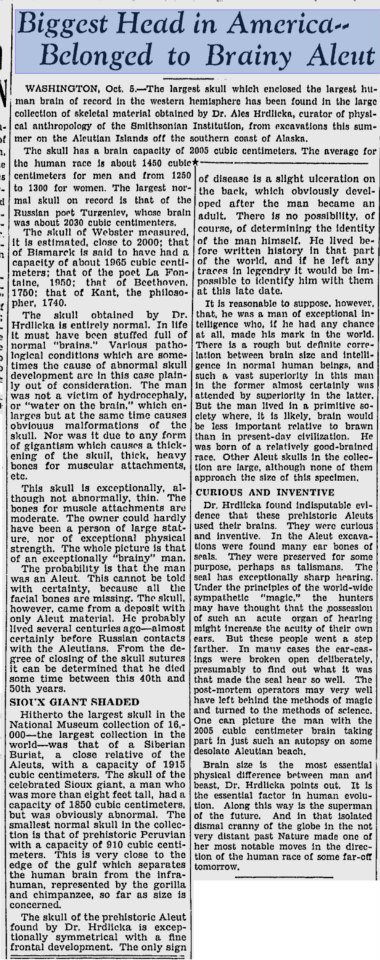Aleutia, Biggest Head in America
Biggest Head in America Belonged to a Brainy Aleut
WASHINGTON, Oct. 5. ~ The largest skull which enclosed the largest human brain on record in the western hemisphere has been found in the large collection of skeletal material obtained by Dr. Ales Hrdlicka, curator of physical anthropology of the Smithsonan Institution. from excavations this summer on the Aleutian Islands off the southern coast of Alaska. The skull has a brain capacity of 2005 cubic centimeters, the average for the human race is about 1450 cubit centimeters for men and 1250 to 1300 for women. The largest normal skull on record is that of the Russian poet Turgeniev, whose brain was about 2030 cubic centimeters. The skull of webster measured, it is estimated, close to 2000; that of Bismarck is said to have had a capacity about 1965 cubic centimeters; that of the poet La Fontaine, 1950;that of Beethoven, 1750; that of Kant, the philosopher 1740.The skull obtained by Dr. Hrdlicka is entirely normal. In life it must have been stuffed full of normal “brains.” Various pathological conditions which are sometimes the cause of abnormal skull development are in this case plainly out of consideration. The man was not a victim of hydrocephaly, or “water on the brain,” which enlarges but at the same times causes obviousmalformations of the skull. Nor was it due to any form of gigantism which causes a thickening of the skull, thick, heavy bones for musculature attachments, etc. Biggest Head in America
This skull is exceptionally, although not abnormally thin. the bones for muscle attachments are moderate. The owner could hardly have been a person of large stature, nor of exceptional physical strength. The whole picture is that
of an exceptionally “brainy” man.
The probability is that the man was an Aleut. This cannot be told with certainty, because all the facial bones are missing. The skull however came from a deposit with only Aleut material. He probably lived several centuries ago-almost certainly before the Russian contacts with the Aleutians. From the degree of the closing of the skull sutures it can be determined that he died some time between this 40th and 50th years.
Sioux Giant Shaded
Hitherto the largest skull in the National Museum collection of 16,000- the largest collection in the world-was that of a Siberian Buriat, a close relative of the Aleuts. with a capacity of 1915 cibic centimeters. The skull of the celebrated Sioux Giant a man who was more than eight feet tall, had a capacity of 1850 cubic centimeters, but was obviously abnormal. The smallest normal skull in the collection is that of a prehistoric Peruvian with a capacity of 910 cubic centimeters. This is very close to the edge of the gulf which separates the human brain from the infrahuman, represented by the gorilla and chimpanzee. (cough crazytalk cough) so far as the size is concerned.
The skull of the prehistoric Aleut found by Dr. Hrdlicka is exceptionally symmetrical with a fine frontal development. The only sign of disease is a slight ulceration on the back, which obviously developed after the man became an adult. There is no possibility of course, of determining the identity of the man himself. He lived before written history in that part of the world, and if he left any traces in legendry it would be impossible to identify him with them at this late date.
It is reasonable to suppose, however, that, he was a man of exceptional intelligence who, if he had any chance at all, made his mark on the world. There s a rough but definite correlation between brain size and intelligence in normal human beings, and such a vast superiority in the latter. But the man lived in a primitive society where, it is likely brain would be less important than brawn than in present day civilization. (the opposite is the case)
He was born of a relatively good-brained race. Other Aleut skulls in the collection are large, although none of them approach the size of this specimen.
CURIOUS AND INVENTIVE
Dr. Hrdlicka, found indesputable evidence that these prehistoric Aleuts used their brains. They were curious and inventive. In the Aleut excavations were found many ear bones of seals. They were preserved for some purpose, perhaps as talismans. The seal has exceptionally sharp hearing. Under the principles of the world wide sympathetic “magic.” The hunters may have thought that the possession of such an acute organ of hearing might increase the acuity of their own ears. But these people went a step farther. In many cases the carcasings were broken open deliberately, presumably to find out what it was that made the seal hear so well. The post mortom-operators may have left behind the methods of magic and turned to the methods of science. One can picture the man with the 2005 cubic centimeter centimeter brain taking part in just such an autopsy on some desolate Aleutian beach.
points out. It is the essential factor in human evolution (devolution). Along this way is the Superman of the future. (past) And in that isolated dismal cranny of the globe in the not very distant past Nature (evolution’s supernatural designer) made one of “her” (mother nature) most notable moves in the direction of the human race of some far off tomorrow, . . . not likely. a better answer is :
Greater Ancestry
THE NEW YORK TIMES HEADLINES:
1) Skull of ‘Braniest American’ Unearthed By Dr. Ales Hrdlicka in Aleutian Islands [Oct 5, 1936]
2) THE BRAINY ALEUT [Oct 6, 1936]
3) Berkeley Daily Gazette, 5 October 1936. Page 2.
4) Rochester Journal. October 5, 1936, Page 10.
Research done by Rephaim23

Comment